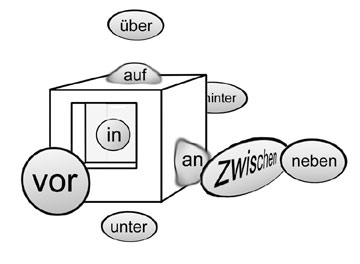![]()
A. Two-way prepositions (Wechselpräpositionen)
German has nine prepositions which can take either the accusative case or the dative case. They are referred to as two-way prepositions. The accusative case is used when the verb indicates motion and answers the question where to (wohin)? The dative case is used when the verb indicates position and answers the question where (wo)?

(Source: https://yourdailygerman.com/german-two-way-prepositions/)
Two-way
prepositions an on,
at (vertical surfaces, edge or border of two entities) auf on
(horizontal surfaces) hinter behind in in,
into, to neben beside,
next to über over,
above unter under vor in
front of zwischen between
to (vertical surfaces)
at, to (often public locations)
across
Accusative
(Motion towards a goal: Wohin?)
Wohin legte Peter die schmutzigen Kleider?
Where did he put the dirty clothes?Er legte die schmutzigen Kleider unter den Stuhl.
He put the dirty clothes under the chair.Er legte die schmutzigen Kleider unter das Bett.
He put the dirty clothes under the bed.Er legte die schmutzigen Kleider in die Waschmaschine.
He put the dirty clothes in the washer.
Dative
(No motion: Wo?)
Wo sind die schmutzigen Kleider?
Where are the dirty clothes?Die schmutzigen Kleider sind unter dem Stuhl.
The dirty clothes are under the chair.Die schmutzigen Kleider sind hinter dem Bett.
The dirty clothes are behind the bed.Die schmutzigen Kleider sind in der Waschmaschine.
The dirty clothes are in the washer.Die sauberen Kleider sind im Wäschetrockner.
The clean clothes are in the dryer.
an on,
at (vertical surfaces)
to (vertical surfaces, locations, edge or border of two entities)
Er hängt das Bild an die Wand. (Wohin?)
He is hanging the picture on the wall.
Peter steht an der Tür. (Wo?) (Edge/border between inside and outside)
Peter is standing at the door.
Seine Freunde gehen an den Strand. (Wohin?) (Edge/border between land and sea)
His friends are going to the beach.
auf on
(horizontal surfaces)
at, to (often public locations)
Seine Bücher sind auf dem Tisch. (Wo?)
His book are on the table.
Er muss noch auf die Post gehen. (Wohin?)
He still has to go to the post office.
Am Abend geht er auf eine Party. (Wohin?)
He is going to a party this evening.
hinter behind
Seine Stereoanlage steht hinter dem Tisch. (Wo?)
His stereo is behind the table.
in in,
into, to
Peters Mutter ist in der Küche. (Wo?)
Peter's mother is in the kitchen.
Peter geht in sein Zimmer, weil er aufräumen muss. (Wohin?)
Peter goes into his room because he needs to clean up.
Heute Abend geht er nicht ins Kino. (Wohin?)
He isn't going to the movies this evening.
neben beside,
next to
Die schmutzige Wäsche liegt neben dem Wäschekorb. (Wo?)
The dirty laundry is next to the laundry basket.
über
over,
above
Eine alte Lampe hängt über dem Schreibtisch. (Wo?)
An old lamp hangs above the desk.
unter under
Er wirft die schmutzige Wäsche unter das Bett. (Wohin?)
He pushes the dirty laundry under the bed.
Die schmutzige Wäsche liegt unter dem Bett. (Wohin?)
The dirty laundry is under the bed.
vor in
front of
Der Kaffeetisch steht vor dem Sofa. (Wo?)
The coffee table is in front of the sofa.
Ich stelle den Kaffeetisch vor das Sofa. (Wo?)
I place the coffee table in front of the sofa.
zwischen between
Peter stellt den Papierkorb zwischen die Stühle. (Wohin?)
Peter puts the paper basket between the chairs.
Der Papierkorb steht zwischen den Stühlen. (Wohin?)
The paper basket is between the chairs.
Note:
The prepositions
an
and dem
contract with the definite
article
dem.
The prepositions an,
in,
and auf
contract with the definite
article
das.
an + dem --->
am
in + dem
--> im
an +
das-->
ans
in +
das--> ins
auf +
das--> aufs